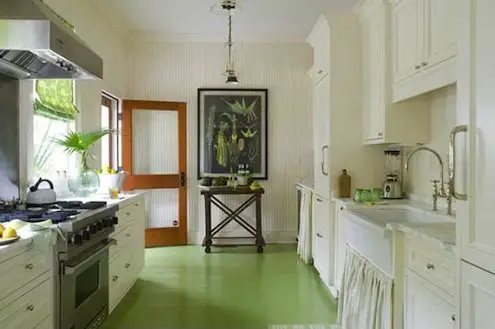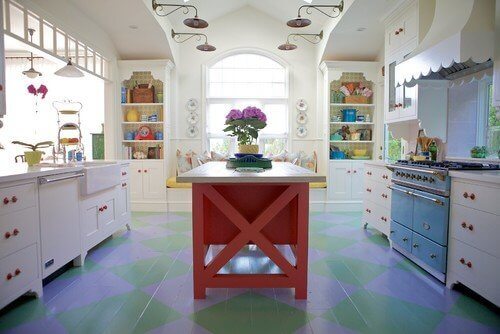Tiles are known for their durability but after a while, your tile can take a beating and become worn out and even damaged. If you are looking to revamp your floor without having to change the entire tile, you can use paint them.
Are you wondering if you can paint kitchen floor tiles? Well, the answer is yes. You can paint your kitchen tile floor tiles to get your floor looking brand new without having to change the tiles.
Read: How to get rid of maggots on kitchen floor
How To Paint Kitchen Floor Tiles
Table of Contents
Prepare the Tiles
You need to start by washing your tiles thoroughly using grime- removing trisodium phosphate cleaner (TSP).
TSP can be purchased in powder form and mixed with water to create a very strong cleaning agent that is very effective in removing dirt, grease, soot, and oils from the surface of your kitchen floor tiles.
Before handling TSP you need to wear protective clothing like gloves, long pants, and long sleeves as well as a respirator if possible, you do not want the chemical to come in contact with your skin, you also need to make sure the working area is properly ventilated.
Combine half-cup of TSP with a gallon of water, you can adjust this measurement according to how concentrated you want the mixture to be, but keep in mind that this concentration is very strong, way stronger than any all-purpose cleaner you may own.
You will need a scrub brush and different dry rags. Soak the scrub brush in the mixture and start using it to scrub the floor and remove both visible and invisible stains, while scrubbing makes sure to frequently rinse and re-saturate the brush with the mixture.
After scrubbing the floor thoroughly, remove excess moisture by wiping the floor with a dry rag. Repeat this process until the entire tile and grout have been cleaned thoroughly.
Finally, allow the newly cleaned area to air dry completely after wiping it with a towel, you need to make sure the space is properly ventilated during the drying process.
Sand the Tiles
Next, get an orbital palm sander with fine-grit sandpaper and use it to eliminate extra finishes on the tile, especially if you have a glossy tile surface.
After sanding the floor, use a clean, damp cloth to remove the dust and debris particles left behind during the sanding process. You need to remove all the dust and debris before proceeding to the next step which is priming.
Prime the Tiles
Priming your floor tiles is a very important but often overlooked step. Always opt for a high-adhesion primer to enable the floor to become an ideal environment for the paint.
Using a High-adhesion primer will create a chemical reaction that causes the primer to bond to the tile while also creating a surface that will be suitable for painting.
Using a primer before painting will help to prevent peeling and flaking of the paint after a while. A primer may cost you a few extra bucks but will be worth it in the long run.
To apply the primer to the tile surface Use a roller and ensure to distribute it evenly to prevent buildup in different areas. An unevenly applied primer will be visible when the floor is painted.
So apply the primer evenly and allow it to dry completely according to the manufacturer’s instructions.
After prepping the floor, apply painter’s tape to where the baseboards meet the tile to protect it from paint splatter once the floor is prepped, protect nearby baseboards from paint splatter.
You can also cover your grout lines with acrylic masking tape If you don’t want to paint the grout lines.
Select your Paint
There are different types of paint you can use to paint your floor tiles, they include;
Chalk Paint
This type of paint can be applied without primer and it gives your floor tile a shabby-chic solid color which can also serve as a base coat for a patterned finish.
If you decide to use chalk paint as a base coat, you need to opt for a shade that will visually contrast with the color of the pattern that it will be overlaid with.
Latex Paint
This type of paint is suitable for both solid and patterned tile floors; if you have solid tiles select a semi- or high-gloss latex paint but if you have patterned tiles go for high-gloss latex paint.
Oil-Based Paint
This type of paint is more durable and holds up better than latex paint because it is less prone to chipping and damage. The downside to oil-based paint is that it takes a longer time to dry, and due to environmental concerns oil-based paint can be hard to find.
Always opt for a high-gloss or semi-gloss paint if you intend to use an oil-based paint.
Primer makes it easy for the paint to adhere to the surface especially if you are making use of latex or oil-based paint, so apply an epoxy or urethane bonding primer to the floor tiles using a brush or roller before painting the tiles.
Apply Paint to Floor Tiles
If you have a large surface area to cover, you will need a brush or roller to apply the paint over the exposed tile and grout in a back and forth motion.
But if you are only painting random or alternating tiles instead of the entire floor, you need to start by cutting in with a brush along the edge of one tile with an angled brush and use either a brush or roll paint to cover the rest of the tile in unidirectional strokes
Repeat this process until every tile you intend to paint has been covered. If you have trouble spreading the paint, you can mix in a little paint thinner.
If you are going for a solid-colored tile design, then you are done painting. Allow the paint to dry for at least two or three days. Then using a clear water-based sealer seal the tile by applying at least two or three coats of the water-based sealer.
Avoid using an oil-based sealer as it can cause the floor to become yellowish, make sure to allow the first coat of the sealer to dry completely before applying the next.
After applying the sealer, you can remove any masking tape and even paint over the grout lines if you so desire.
If you are opting for a patterned tile floor, do not seal the tile just yet. Allow the floor to dry for two or three days before proceeding with the pattern application, and seal the floor after the pattern has dried.
Read: Can you paint laminate floors?
Applying A Pattern
Using a stencil is The easiest way to apply a pattern to painted tile. you can either opt for a quilt-like pattern or a sharper geometric pattern.
Start by buying or DIYing a stencil that fits the dimensions of your tiles, making sure that The outer edge of the graphic inside the stencil reaches the outer edges of the tile.
You can use painter’s tape to secure the stencil to the floor, making sure you do not cover any parts of the graphic with the tape. Then, use a roller with a foam roller cover to apply the paint of your choice directly over the stencil.
When applying the paint ensure to work in sections by rolling over one section of the stencil at a time instead of trying to paint across the entire stencil at once because this can create roller marks which is one of the most common problems encountered by home painters.
Continue repeating this process and move the stencil from one tile to another, making sure you do not mar the freshly painted tiles with the stencil.
If you happen to have half or partial tiles at the edge of the floor, you can paint over it using the stencil. You can also make use of an artist’s paintbrush to carry out any necessary touch-ups to the pattern.
After covering the entire floor with paint allow it to dry completely before applying a clear water-based sealant.
Protecting Your Painted Floor Tiles
Applying a high-quality sealant to your painted floor will help to protect it from grime, moisture, mold, scuff marks, and even scratches that result from heavy foot traffic.
Read: How to get rid of mold
Try to create a regular cleaning routine for your floor and regularly sweep, vacuum, and even damp-mop the floor to remove dust and debris particles from the floor. This will help to retain the sheen of your painted tile floor and protect your applied pattern.
You can also provide an extra barrier of protection for your tile floor from the impact of everyday wear-and-tear by placing mats in high-traffic areas and floor pads underneath furniture placed on the tile.
To clean your painted floor tile, ensure to use neutral pH solvents and gently scrub them into the floor with a non-abrasive chamois mop. Do not use steel wool, scouring pads, or chemical cleaners on your painted tile floor as it can discolor or erode the paint.
Read: How to remove paint from floor tiles
When cleaning your floor, do not allow cleaners or plain water to sit on the floor for too long because excess moisture can cause the paint to start peeling.
For stubborn stains or heavy grime-ridden floor, you can make use of A mixture of baking soda and warm water which is a gentle homemade cleaner to clean your floor, this mixture can also be used to clean your grout lines.
After achieving your desired results with this homemade cleaner, wipe the tile dry with a lint-free cloth.
Related: How to get rid of maggot on kitchen floor
Conclusion
Can you paint kitchen floor tiles? This question is probably on your mind after seeing your floor all worn out and beat down. Thankfully the answer to this question is yes! You can paint your kitchen floor tiles to give it a new lease of life and revamp its look.
Although this isn’t a permanent fix, this can buy you some time until you are able to replace the entire floor.

